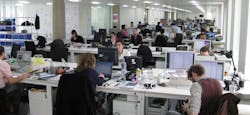The importance of quiet and the consequences of distraction
I’ve got to admit: There are days when I wish I could lower the “cone of silence” and get some work done in the office.
It’s not that I don’t like conversing with my neighbors or enjoy our open office design, but there are times when the bouquet of interesting distractions around me make it difficult to stay in a groove and crank out some complex analysis. As a workplace design practitioner, I know I’m not alone in my community of office dwellers whose strong need to control acoustic and visual privacy is a priority.
Distraction comes in many forms: visual, acoustic, thermal, lighting. Even the smell of microwavable popcorn from the nearby kitchenette is enough to disrupt one’s train of thought.
It may seem trivial, but there are real consequences to being distracted. Recent work style studies show that the average knowledge worker spends 25-35% of their time doing heads-down focused work. Once thrown off track, it can take some 23 minutes for a worker to return to the original task, according to Gloria Mark, a professor of informatics at the University of California, Irvine who studies distraction.
A Steelcase study recently published in The Harvard Business Review found that “98% of the most highly engaged employees reported that they had ‘the ability to concentrate easily’ in their workplace and that this attribute is a top factor in their satisfaction.”
While collaboration, open workplace, and flexibility remain the top three desired workplace attributes, lack of privacy is consistently the top cause of lost efficiency reported by respondents from our post-occupancy evaluations. Metrics like these prove that the sanctity of the quiet place needs to be preserved!
With the wave of new workplace trends, technologies, and mobile work practices, it’s no wonder that knowledge workers everywhere are coveting privacy in their workplace. We have more to do in less time with higher expectations for better outcomes. All the while, we are expected to increase collaboration with co-workers and share knowledge.
With this shift in how work is done comes a corresponding shift in where it is done, which tools are used, and who we need to interact with. This is why an office filled with only open bench-style seating doesn’t always cut it for workers who need time and space to focus. The best way forward is to provide a choice of settings for workers to do the variety of activities required during the day.
In addition to designing workplaces, my job includes researching and analyzing the fit between the environment and socio-cultural behavior as well as socio-spatial relationships. Maybe I know too much about this topic to be able to block out the distractions around me?
About the Author: Allison Arnone is a Principal Workplace Strategist in HDR's Princeton, N.J., office. More on Arnone.
